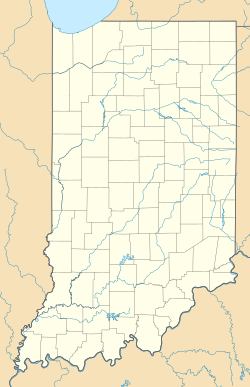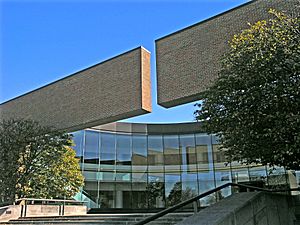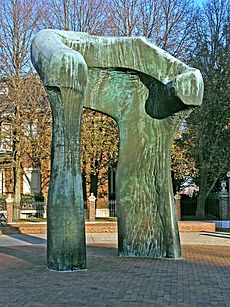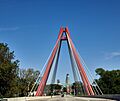Columbus, Indiana facts for kids
Quick facts for kids
Columbus
|
|||
|---|---|---|---|
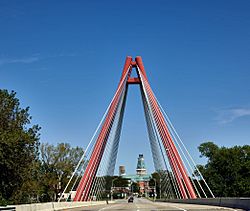
The Robert N. Stewart Bridge (foreground), with the Bartholomew County Courthouse and First Christian Church visible in the background.
|
|||
|
|||
| Nickname(s):
"Athens on the Prairie"
|
|||
| Motto(s):
"Unexpected. Unforgettable"
|
|||
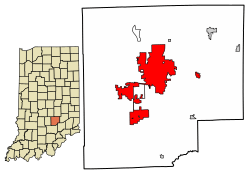
Location of Columbus in Bartholomew County, Indiana
|
|||
| Country | United States | ||
| State | Indiana | ||
| County | Bartholomew | ||
| Area | |||
| • Total | 28.75 sq mi (74.47 km2) | ||
| • Land | 28.41 sq mi (73.59 km2) | ||
| • Water | 0.34 sq mi (0.88 km2) | ||
| Elevation | 627 ft (191 m) | ||
| Population
(2020)
|
|||
| • Total | 50,474 | ||
| • Density | 1,776.44/sq mi (685.90/km2) | ||
| Time zone | UTC−5 (EST) | ||
| • Summer (DST) | UTC−4 (EDT) | ||
| ZIP Codes |
47201–47203
|
||
| Area code(s) | 812 and 930 | ||
| FIPS code | 18-14734 | ||
| GNIS feature ID | 2393609 | ||
Columbus is a city in Bartholomew County, Indiana, United States. It is also the county seat. In 2020, about 50,474 people lived there.
Columbus is famous for its amazing buildings and public art. Since the mid-1900s, many famous architects have designed buildings here. The yearly Exhibit Columbus event celebrates this special history.
The city is about 40 miles (64 km) south of Indianapolis. It sits on the east fork of the White River. Columbus is the 20th largest city in Indiana. It is also the main city of the Columbus, Indiana metropolitan area. This area includes all of Bartholomew County. Former Indiana Governor and U.S. Vice President, Mike Pence, was born in Columbus.
The engine company Cummins has its main office in Columbus. In 2004, Nick Jr. Family Magazine called Columbus one of "The Ten Most Playful Towns." GQ magazine also named it one of the "62 Reasons to Love Your Country" in 2005. Columbus won the "America in Bloom" contest in 2006. In 2008, National Geographic Traveler magazine ranked Columbus 11th on its list of historic places. They called the city "authentic, unique, and unspoiled."
Contents
History of Columbus
The land where Columbus is now was bought by General John Tipton and Luke Bonesteel in 1820. Tipton built a log cabin on a small hill called Mount Tipton. This hill overlooked the White River and the nearby flat, swampy forest.
The town was first called Tiptona, after John Tipton. But on March 20, 1821, the name was changed to Columbus. Some people think Tipton was unhappy about this, but there is no proof. He later left the new town and never came back.
John Tipton became a highway commissioner for Indiana. He was in charge of building a road from Indianapolis, Indiana to Louisville, Kentucky. When the road reached Columbus, Tipton built the first bypass road ever. It went south around the west side of Columbus, heading towards Seymour.
Joseph McKinney was the first person to draw out the town of Columbus. The exact date is not known. For many years, local history books said Tipton gave the land for free. But in 2003, a document was found showing that Tipton had actually sold the land.
A ferry was set up where the Flatrock and Driftwood rivers meet to form the White River. A small village with a few log cabins grew around the ferry. A store was added in 1821. Later that year, Bartholomew County was formed. It was named after General Joseph Bartholomew. Columbus officially became a city on June 28, 1864.
The first railroad in Indiana was built to Columbus from Madison, Indiana in 1844. This railroad later became part of the Pennsylvania Railroad. The railroad helped Columbus grow into one of Indiana's largest communities. By 1850, three more railroads reached the city.
The Crump Theatre in Columbus was built in 1889 by John Crump. It is the oldest theater in Indiana. Today, it is part of the Columbus Historic District. The theater closed in 2010.
The Cummins Bookstore opened in Columbus in 1892. It was the oldest bookstore in Indiana that had been open continuously. It closed in late 2007.
The Irwin Union Bank building was built in 1954. It was named a National Historic Landmark in 2001 because of its special architecture. The building has a one-story bank area next to a three-story office part. Eero Saarinen designed the bank building with glass walls. This made it look very different from old, traditional bank buildings. Saarinen wanted the bank to feel welcoming, not scary, to customers.
Economy and Jobs
Columbus has been home to many manufacturing companies. One example is Noblitt-Sparks Industries, which made radios in the 1930s. This company later became Arvin Industries, now called Meritor.
Cummins is the biggest employer in the area. The Infotech Park in Columbus also provides many research jobs. Just south of Columbus is the North American headquarters of Toyota Material Handling. This is the world's largest company that makes forklifts.
Architecture is another important industry in Columbus. The city is famous for its modern buildings around the world. Joseph Irwin Miller, a former leader of Cummins, started the Cummins Foundation. This foundation helps pay for many architectural projects in the city. It supports new engineers and architects.
In the early 1900s, Columbus also had car manufacturers. One company, Reeves, made unusual cars. These included the four-axle Octoauto and the twin rear-axle Sextoauto around 1911.
Geography of Columbus
The Driftwood and Flatrock Rivers meet in Columbus. They form the East Fork of the White River.
Columbus covers about 27.886 square miles (72.22 km2). Most of this area, about 27.5 square miles (71.2 km2), is land. The rest, about 0.386 square miles (1.00 km2), is water.
Population Information
| Historical population | |||
|---|---|---|---|
| Census | Pop. | %± | |
| 1850 | 1,008 | — | |
| 1860 | 1,840 | 82.5% | |
| 1870 | 3,359 | 82.6% | |
| 1880 | 4,813 | 43.3% | |
| 1890 | 6,719 | 39.6% | |
| 1900 | 8,130 | 21.0% | |
| 1910 | 8,813 | 8.4% | |
| 1920 | 8,990 | 2.0% | |
| 1930 | 9,935 | 10.5% | |
| 1940 | 11,738 | 18.1% | |
| 1950 | 18,370 | 56.5% | |
| 1960 | 20,778 | 13.1% | |
| 1970 | 26,457 | 27.3% | |
| 1980 | 30,614 | 15.7% | |
| 1990 | 31,802 | 3.9% | |
| 2000 | 39,059 | 22.8% | |
| 2010 | 44,061 | 12.8% | |
| 2020 | 50,474 | 14.6% | |
| U.S. Decennial Census | |||
2010 Census Details
In 2010, Columbus had 44,061 people living in 17,787 households. About 11,506 of these were families. The city had about 1,602 people per square mile (618.6 per km2). There were 19,700 homes, with about 716 homes per square mile (276 per km2).
Most people in the city were White (86.9%). Other groups included African American (2.7%), Asian (5.6%), and Native American (0.2%). About 5.8% of the population was Hispanic or Latino.
About 33.5% of households had children under 18. Almost half (48.5%) were married couples. About 29.7% of households were single people. About 11.5% of people living alone were 65 or older. The average household had 2.43 people, and the average family had 3.00 people.
The average age in Columbus was 37.1 years. About 25.2% of residents were under 18. About 14.4% were 65 or older. The city had slightly more females (51.6%) than males (48.4%).
Arts and Culture in Columbus
Columbus is famous for its modern architecture and public art. J. Irwin Miller, a leader of Cummins, started a special program. The Cummins Foundation would pay for architects' fees. This happened if the client chose an architect from a list the foundation made. This plan started with public schools and worked very well. So, the foundation began offering this design help to other non-profit groups and city organizations.
Many famous buildings and artworks in Columbus were designed by great artists. These include Eero Saarinen, I.M. Pei, Robert Venturi, Cesar Pelli, and Richard Meier. Because of this, Columbus is sometimes called "Athens on the Prairie."
Seven buildings built between 1942 and 1965 are National Historic Landmarks. About 60 other buildings also show off Columbus's reputation for modern architecture. National Public Radio even did a story about the town's architecture.
In 2015, Landmark Columbus was created. This group helps continue the city's tradition of great design. Exhibit Columbus is part of this effort.
Besides the Columbus Historic District and Irwin Union Bank, many other buildings are listed on the National Register of Historic Places. These include:
- Bartholomew County Courthouse
- Columbus City Hall
- First Baptist Church
- First Christian Church
- Haw Creek Leather Company
- Mabel McDowell Elementary School
- McEwen-Samuels-Marr House
- McKinley School
- Miller House
- North Christian Church
- The Republic Newspaper Office
The 2017 movie Columbus was filmed in the city. Independent filmmaker Kogonada shot the movie there over 18 days in 2016.
National Historic Landmarks
- First Baptist Church was designed by Harry Weese. It has no windows and a high roof. It opened in 1965.
- First Christian Church was designed by Eliel Saarinen. It has a 160-foot (49m) tower and opened in 1942. It was one of the first modern church buildings in America.
- Irwin Union Bank was designed by Eero Saarinen. It opened in 1954. It might be the first bank in America to use glass walls and an open design.
- The Mabel McDowell School opened in 1960. It was designed by John Carl Warnecke. Its architect's fee was the second one paid by the Cummins Engine Foundation.
- The Miller House and Garden was built in 1957. It was designed by Eero Saarinen and landscaped by Dan Kiley. It was built for J. Irwin Miller of Cummins.
- North Christian Church was designed by Eero Saarinen. It is shaped like a hexagon and has a 192-foot (59m) spire. It opened in 1964.
- The Republic Newspaper Office was designed by Myron Goldsmith at SOM.
- Zaharakos Ice Cream Parlor
Other Important Modern Buildings
- St. Bartholomew Catholic Church, by William Browne Jr. and Steven Risting
- Cleo Rogers Memorial Library, by I. M. Pei
- Columbus East High School, by Romaldo Giurgola
- Commons Centre and Mall, by César Pelli
- St. Peter's Lutheran Church, by Gunnar Birkerts
- Lincoln Elementary School, by Gunnar Birkerts
- Otter Creek Golf Course, by Harry Weese
- Fire Station Number 4, by Robert Venturi
- Columbus Regional Hospital, by Robert A.M. Stern
Notable Historic Buildings
- Bartholomew County Courthouse by Isaac Hodgson
- Columbus Power House by Harrison Albright
- The Crump Theatre by Charles Franklin Sparrell
Public Artworks
- Chaos I by Jean Tinguely
- Friendship Way by William A. Johnson
- Irwin Gardens at the Inn at Irwin Gardens
- Large Arch by Henry Moore
- 2 Arcs de 212.5˚ by Bernar Venet
- Horses by Costantino Nivola
- The Family by Harris Barron
- Yellow Neon Chandelier and Persians by Dale Chihuly
- C by Robert Indiana
- Sermon on the Mount by Loja Saarinen and Eliel Saarinen
- History and Mystery by William T. Wiley
- Exploded Engine by Rudolph de Harak
- Eos by Dessa Kirk
Exhibit Columbus
In May 2016, Landmark Columbus started Exhibit Columbus. This program helps continue the city's design traditions. Exhibit Columbus has events every year. These include symposiums (discussions) and exhibitions (shows).
Sports in Columbus
Columbus High School was where Chuck Taylor played basketball. He later became famous for promoting his shoes and the sport of basketball. He is now in the Naismith Memorial Basketball Hall of Fame.
Columbus has two local high schools, Columbus North and Columbus East. Both schools have strong sports teams. Many athletes from these schools go on to play in college and beyond. Columbus North High School has one of the largest high school gyms in the United States.
The Indiana Diesels basketball team plays their home games at the gym at Ceraland Park. They are part of the Premier Basketball League. They plan to move to a new sports complex downtown soon.
Parks and Fun Activities
Columbus has over 700 acres (2.8 km2) of parks and green spaces. It also has over 20 miles (32 km) of "People Trails" for walking and biking.
The Columbus Parks and Recreation Department manages these areas. They also take care of several sports and community places. These include:
- Donner Aquatic Center (swimming)
- Lincoln Park Softball Complex
- Hamilton Center Ice Arena
- Clifty Park
- Foundation for Youth/Columbus Gymnastics Center
- The Commons (community center)
Transportation
Bus Service
ColumBUS provides bus service within the city. It has five routes that run Monday through Saturday.
Roads and Highways
The main north-south road, US Route 31, goes around the northeastern part of the city. Interstate 65 goes around Columbus to the west. Indiana Route 46 runs east-west through the southern part of the city.
Train Service
Freight (cargo) train service is provided by the Louisville and Indiana Railroad (LIRC). The LIRC line runs north-south along the western edge of Columbus.
Passenger trains used to stop in Columbus. The Pennsylvania Railroad's Kentuckyian stopped until 1968. The South Wind also stopped until 1971.
Columbus has been chosen as a possible location for a new Amtrak train station. This station would be part of a train route connecting Chicago, Indianapolis, and Louisville.
Airport
Columbus is served by the Columbus Municipal Airport (KBAK). It is about 3 miles (4.8 km) north of Columbus. The airport handles about 40,500 flights each year. Most of these are general aviation (private planes).
The airport has two concrete runways. One is 6,401 feet (1,951 m) long. The other is 5,001 feet (1,524 m) long.
The closest airport with regular passenger flights is Indianapolis International Airport (IND). It is about 55 miles (88.5 km) northwest of Columbus. Louisville Muhammad Ali International Airport is 78 miles (125.5 km) south. Cincinnati/Northern Kentucky International Airport is 83 miles (133.5 km) southeast.
Notable People from Columbus
This is a list of famous people who were born in, live in, or have lived in Columbus:
- Ross Barbour and Don Barbour, singers in The Four Freshmen
- Michael Evans Behling, actor
- Kate Bruce, silent-film actress
- Clessie Cummins, inventor and founder of Cummins, Inc.
- William H. Donner, businessman and giver to charity
- Tyler Duncan, golfer
- Dutch Fehring, Major League Baseball player
- Arthur W Graham III, created the first automatic electronic race timing system
- Lee H. Hamilton, former member of U.S. Congress
- Jordan Bryce Hutson, gospel musician
- Jamie Hyneman, former host of MythBusters
- Blair Kiel, Notre Dame and pro football quarterback
- Debbi Lawrence, race walker
- Scott McNealy, co-founder of Sun Microsystems
- J. Irwin Miller, industrialist and CEO of Cummins
- Mike Moore, Minor League Baseball president
- Jeff Osterhage, television and film actor
- Bob Paris, author and former Mr. Universe
- Greg Pence, U.S. representative, brother of Mike Pence
- Mike Pence, former Governor of Indiana and U.S. Vice President
- Mike Phipps, NFL quarterback
- Frank Richman, Justice of the Indiana Supreme Court
- Terry Schmidt, NFL cornerback
- Stephen Sprouse, fashion designer
- Tony Stewart, auto racing driver and team owner
- Jill Tasker, television and voice actor
- Chuck Taylor, shoe designer
- Bruce Tinsley, creator of Mallard Fillmore
- Herbert Wright, producer
Education in Columbus
The Bartholomew Consolidated School Corporation (BCSC) is the local school district. High schools in Columbus include:
- Columbus East High School
- Columbus North High School
Columbus has a public library, which is a part of the Bartholomew County Public Library system.
For higher education, Columbus has:
- Indiana University–Purdue University Columbus (IUPUC)
- An Ivy Tech campus
- A Purdue Polytechnic campus
- An Indiana Wesleyan University education center
Images for kids
See also
 In Spanish: Columbus (Indiana) para niños
In Spanish: Columbus (Indiana) para niños



